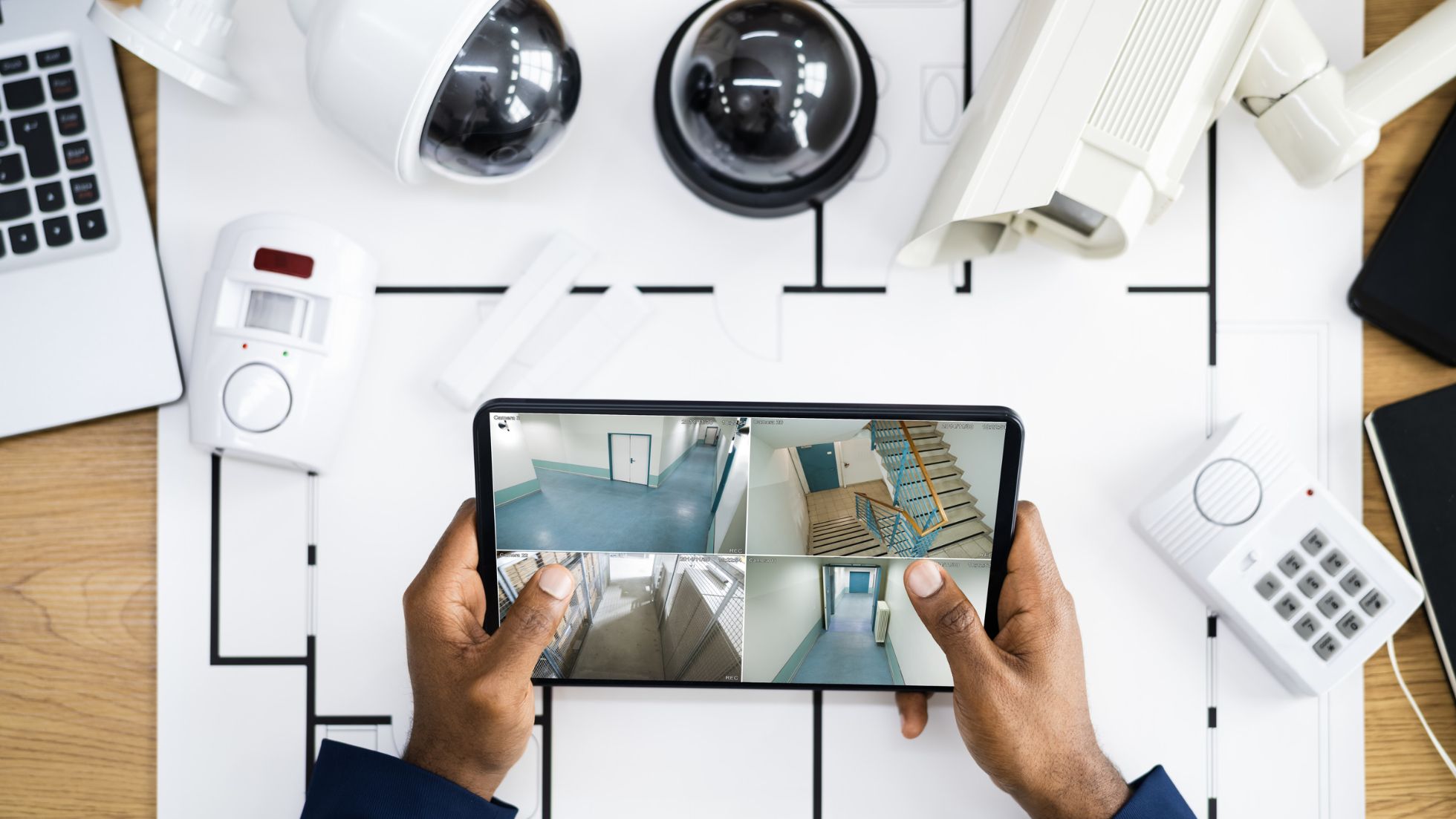

From Wired to Wireless: Discovering the Types of Home Security Systems
- 30. 5. 2023 03:30
In today’s world, ensuring the safety and security of our homes has become increasingly important. Home security systems are crucial in protecting our loved ones and belongings.
Understanding the different types of home security systems available is key to making an informed decision.
From wired and wireless systems to monitored and unmonitored options, as well as the rise of smart home security, this article will explore the various types of home security systems to help you choose the right one for your needs.
What Are Different Types of Home Security Systems?
The different types of home security systems include wired, wireless, monitored, unmonitored, smart home, and DIY systems. Wired systems use physical connections, while wireless systems rely on signals. Monitored systems provide professional monitoring, while unmonitored systems are self-monitored. Smart home systems integrate with automation and devices, and DIY systems allow for self-installation.

Wired Home Security Systems
Wired home security systems have been a reliable choice for many years. They consist of a network of interconnected devices that communicate through physical wiring—typically installed during the construction or renovation of a home.
Popular examples of wired home security systems include ADT, Honeywell, and Brinks Home Security. These systems offer peace of mind with their robust and stable connections, making them a preferred choice for homeowners seeking a reliable security solution.



Key Points to Keep in Mind:
1. Stability and Reliability
Wired systems offer high stability and reliability since they are not susceptible to wireless interference or signal disruptions. Once installed, the connection remains strong and consistent.
2. Hardwired Components
These systems usually include sensors, control panels, keypads, and cameras that are directly connected through wires. This ensures secure communication and power supply.
3. Professional Installation
Installing a wired system generally requires professional assistance due to the complexities of running wires throughout the house. A technician will carefully place and conceal the wiring to maintain the aesthetic appeal of your home.
4. Power Backup
Wired systems often have a backup battery that keeps them operational during power outages, ensuring continuous protection.
5. Limited Flexibility
Since wired systems rely on physical connections, they are less flexible when it comes to moving or expanding components. Modifications may require additional wiring.
Wireless Home Security Systems
Wireless home security systems have gained popularity recently due to their convenience and flexibility. Unlike wired systems, they use wireless technology to communicate between the various components of the system.
Popular examples of wireless home security systems include Ring, SimpliSafe, and Nest Secure. These systems offer flexibility, convenience, and remote access, making them appealing for homeowners seeking a versatile and easily customizable security solution.



Key Points to Keep in Mind:
1. Easy Installation
Wireless systems are relatively easy to install as they do not require extensive wiring throughout the house. This makes them suitable for renters or those who prefer a DIY installation.
2. Flexibility and Scalability
Wireless systems offer greater flexibility since the components can be easily moved or repositioned as needed. They also allow for easy expansion, enabling you to add more devices and sensors as your security needs evolve.
3. Remote Access and Control
Many wireless systems can be controlled and monitored remotely through a smartphone app or web portal. This feature enables you to arm or disarm your system, receive real-time notifications, and view live camera feeds from anywhere.
4. Battery-Powered Devices
Wireless components, such as sensors and cameras, are typically battery-powered. While this eliminates the need for electrical wiring, it requires periodic battery replacements or recharging.
5. Susceptible to Interference
Wireless systems may experience signal interference or disruptions due to factors like distance, obstacles, or competing wireless devices. However, advanced encryption protocols help ensure secure communication.
Monitored Home Security Systems
Monitored home security systems provide an extra layer of protection by connecting the security system to a professional monitoring service. These systems offer round-the-clock surveillance and prompt response to security events.
Popular examples of monitored home security systems include ADT, Vivint, and Frontpoint. These systems offer continuous monitoring and professional support, ensuring a rapid response to any security incidents for a more secure and protected home.



Key Points to Keep in Mind:
1. Professional Monitoring
With a monitored system, when an alarm is triggered, it immediately alerts a monitoring center staffed by trained professionals. They can assess the situation and take appropriate action, such as contacting emergency services or notifying you and your designated contacts.
2. Enhanced Security
The presence of professional monitoring adds an extra level of security to your home. Even if you’re away or unable to respond, the monitoring team can act swiftly in case of a break-in, fire, or other emergencies.
3. Peace of Mind
Knowing that experts are keeping an eye on your home can provide peace of mind, especially during vacations or extended periods away from home.
4. Monthly Service Fees
Monitored systems typically require a monthly subscription fee for the monitoring service. While this adds to the cost, the benefits of professional monitoring can outweigh the expense for many homeowners.
5. Integration with Other Services
Monitored systems may integrate with additional services like home automation, video surveillance, and remote access, providing a comprehensive security solution.
Unmonitored Home Security Systems
Unmonitored home security systems provide a DIY approach to home security, allowing homeowners to directly manage and monitor their own security without involving a professional monitoring service.
Examples of unmonitored home security systems include SimpliSafe (with optional monitoring), Ring Alarm, and Abode. These systems allow homeowners to manage their own security, offering flexibility, cost savings, and privacy while requiring proactive involvement in security monitoring and response.



Key Points to Keep in Mind:
1. Self-Monitoring
With an unmonitored system, you are responsible for monitoring and responding to security events. This can be done through a smartphone app, computer interface, or by receiving notifications directly from the system.
2. Cost Savings
Unmonitored systems typically do not require monthly subscription fees, resulting in cost savings compared to monitored systems. You have more control over your security expenses.
3. Flexibility and Privacy
Unmonitored systems offer greater privacy since your security events are not shared with a monitoring center. Additionally, you can customize and adjust your system settings according to your preferences.
4. Prompting Self-Action
In the event of an alarm trigger, it is up to you to take immediate action by contacting emergency services, or neighbors, or investigating the situation yourself.
5. Limited External Support
Unmonitored systems lack professional assistance and intervention, which may be a drawback for homeowners who prefer the reassurance of trained experts handling emergency situations.
Smart Home Security Systems
Smart home security systems integrate advanced technology and connectivity to provide a comprehensive and convenient security solution. These systems leverage the power of automation and smart devices to enhance home security.
Examples of smart home security systems include ZoomOn, Nest Secure, and Ring Alarm (with smart home integration). These systems combine convenience, automation, and advanced features to provide an integrated and intelligent security solution for modern homes.



Key Points to Keep in Mind:
1. Home Automation Integration
Smart security systems seamlessly integrate with other smart devices and home automation features, such as smart locks, video doorbells, motion sensors, and home security cameras. This allows for a unified and interconnected smart home ecosystem.
2. Remote Control and Monitoring
The smart home security system can be controlled and monitored remotely through smartphone apps or web interfaces. Including arming/disarming the system, receiving real-time alerts, and accessing live camera feeds from anywhere.
3. Customization and Personalization
Smart systems offer extensive customization options, allowing you to tailor security settings and automation routines according to your preferences and lifestyle.
4. Voice Control
Many smart security systems are compatible with popular voice assistants, enabling hands-free control and managing your security devices using voice commands.
5. Enhanced Connectivity
Smart systems utilize wireless connectivity, such as Wi-Fi or Zigbee, for seamless communication between devices. This ensures quick and reliable data transmission.
DIY Home Security Systems
DIY (Do-It-Yourself) home security systems offer homeowners the freedom to install, customize, and manage their own security systems without needing professional installation or monitoring services.
Popular examples of DIY home security systems include ZoomOn, SimpliSafe, and Ring Alarm. These systems empower homeowners with the ability to take charge of their security, offering affordability, customization, and control over the installation and monitoring process.



Key Points to Keep in Mind:
1. Cost-Effective
DIY systems are typically more affordable than professionally installed alternatives since you can avoid installation fees and monthly monitoring fees.
2. Easy Installation
DIY systems are designed to be user-friendly and straightforward to install. They often come with step-by-step instructions and pre-programmed components, making installation accessible for individuals with basic technical skills.
3. Customization and Scalability
DIY systems allow you to choose the specific components and features that meet your security needs. You have the flexibility to add or remove devices as your requirements evolve.
4. Self-Monitoring
With DIY systems, you monitor and respond to security events. This can be done through smartphone, tablet, or PC app and notifications, giving you direct control over your security.
5. Learning Curve
DIY systems require some technical understanding and troubleshooting skills. However, manufacturers usually provide customer support and online resources to assist with setup and maintenance.

How to Choose the Right Home Security System
Choosing the right home security system involves several key considerations. Begin by assessing your specific security needs, such as the size of your property and potential vulnerabilities.
Consider your budget for upfront and ongoing expenses, including equipment, installation, and monitoring fees. Evaluate the features and components different systems offer, ensuring they meet your requirements.
Decide whether you prefer professional monitoring or self-monitoring options based on your preferences and level of involvement. Consider the security system provider’s ease of use, customer support, and reputation.
Lastly, review contract terms and long-term commitments. By carefully evaluating these factors, you can make an informed decision and select a home security system that provides you and your family the right level of protection and peace of mind.
Here is your 101 guide on how to choose a home security system.
Conclusion
Selecting the right home security system is a crucial step in safeguarding your home and ensuring the well-being of your loved ones. With the wide array of options available, assessing your security needs, considering your budget, and weighing the features and benefits of different systems is essential.
Whether you opt for a wired system for stability, a wireless system for flexibility, a monitored system for professional support, a smart system for automation, or a DIY system for customization, all these types of home security systems have their own advantages.
Ultimately, the key is to choose a system that aligns with your specific requirements, offers reliable protection, and provides peace of mind.

FAQ: Types of Home Security Systems
The seven types of alarm systems are wired, wireless, monitored, unmonitored, smart home, DIY, and burglar alarm systems.
The four categories of alarm systems are intrusion alarms, fire alarms, environmental alarms, and medical alarms.
The three types of alert alarms are audible, visual, and silent.
The major types of alarm systems include intrusion, fire, and environmental alarms.
The best security system for your home depends on your specific needs, preferences, and budget. However, here is a general ranking of home security systems from most used to least used: wireless, smart, DIY and the least used are wired home security systems.
It is generally recommended to have both – a security system and cameras for comprehensive home protection.
- 30. 5. 2023 03:30





